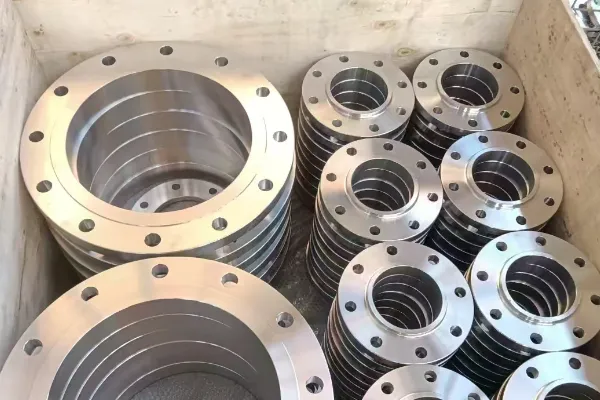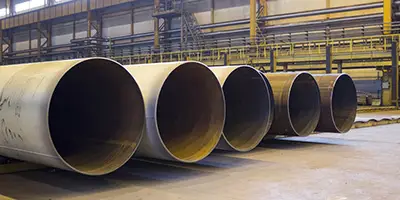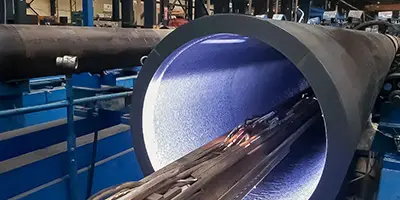The use of flanges in industrial structural parts is mainly to improve the connection function and keep the pipeline sealed without leakage. However, many flanges will corrode and age after a period of use, thus losing their sealing function. Therefore, it is necessary to conduct corrosion tests on flanges regularly. Here I will share with you the process of measuring flange corrosion.
First of all, it is necessary to ensure that the flanges are regularly maintained and inspected. When corrosion occurs, it usually manifests as thinning of the flange wall, local pits and pitting. The causes and methods of internal corrosion of stainless steel flanges need to be carried out in a certain way and principle. At present, the more widely used flange corrosion detection methods at home and abroad are leakage magnetic method and ultrasonic detection method.
The ultrasonic detection method uses the pulse reflection principle of ultrasonic waves to measure the wall thickness after corrosion. The basic principle of the leakage magnetic method is based on the high magnetic permeability of ferromagnetic materials. The magnetic permeability of the flange corrosion defect is much smaller than that of the flange. The flange is magnetized under the action of the external magnetic field. When there is no defect in the flange, most of the magnetic lines of force pass through the steel pipe, and the magnetic lines of force are evenly distributed at this time; when there is a defect inside the flange, the magnetic lines of force are bent, and part of the magnetic lines of force leak out of the steel pipe surface. By detecting the leakage magnetic flux on the surface of the magnetized flange, it can be determined whether there is a defect.
In addition to detecting the inner surface area of the flange wall, the probe also emits ultrasonic pulses perpendicular to the inner wall of the flange. The ultrasonic probe then receives the reflected pulse from the outer surface area of the pipe. The distance between the pulse and the inner surface area reflects the thickness of the wall. The elbow needs to be inspected according to the actual situation and the instructions in the actual inspection, and the ultrasonic inspection method is a good way to inspect it.
The ultrasonic flaw detection method is also suitable for measuring the metal thickness and performance of other metal structures.
In order to ensure that the installed flange does not leak oil, what problems should be paid attention to during installation?
1. The flange should have sufficient strength and should not be deformed during tightening. The flange sealing surface should be flat and clean, and oil and rust should be cleaned during installation.
2. The gasket should have good oil resistance and anti-aging properties, as well as good elasticity and mechanical strength. Gaskets of different sections and sizes should be selected according to the shape of the joint during installation, and placed correctly.
3. The flange tightening force should be uniform, and the compression of the rubber pad should be controlled at the left 1/3.
4.During the tightening process, the bolts should be tightened in a cross pattern to ensure even distribution of pressure on the flange and gasket. This helps to avoid uneven stress which can cause deformation or leaks.
5.All bolts and nuts should be checked for corrosion or damage before installation. Using high-quality, corrosion-resistant fasteners will improve the long-term sealing performance of the flange.
6.It is essential to use the correct torque as specified for the flange and gasket type. Over-tightening can damage the flange or gasket, while under-tightening may lead to leakage.

Effective Corrosion Protection Measures for Flanges
Corrosion coatings play a vital role in protecting flanges from rust and deterioration. Common protective coatings such as epoxy resin, polyurethane, and zinc-based paints form a barrier against moisture and corrosive substances. Proper surface preparation before coating application—ensuring the flange is clean and free of oils—is crucial to achieve a uniform and defect-free layer that maximizes protection.
Using Corrosion-Resistant Materials
For environments prone to aggressive corrosion, selecting flanges made from stainless steel, nickel alloys, or other corrosion-resistant materials significantly enhances durability. These materials inherently resist oxidation and chemical attack, thereby reducing the frequency of maintenance and replacement.
Routine Maintenance and Cleaning
Regular cleaning of flange surfaces to remove dirt, grease, and corrosion by-products is essential to slow down corrosion progression. In harsh settings like marine or chemical plants, establishing a scientific maintenance schedule and conducting periodic inspections help detect early signs of corrosion and prevent serious damage.






 English
English Español
Español بالعربية
بالعربية











 Phone :
Phone :  Whatsapp :
Whatsapp :  Email :
Email : 


